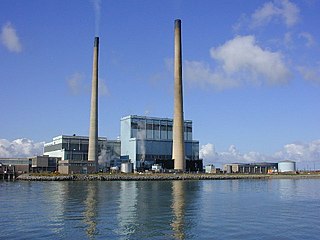The Electricity Supply Board is a state owned electricity company operating in the Republic of Ireland. While historically a monopoly, the ESB now operates as a commercial semi-state concern in a "liberalised" and competitive market. It is a statutory corporation whose members are appointed by the government of Ireland.

Northern Ireland Electricity Networks Limited (NIE Networks) is the electricity asset owner of the transmission and distribution infrastructure in Northern Ireland, established in 1993 when the business was privatised. NIE Networks does not generate or supply electricity. Since 2010 it has been a subsidiary of ESB Group.

The Ferrybridge power stations were a series of three coal-fired power stations on the River Aire near Ferrybridge in West Yorkshire, England, in operation from 1927 to 2016 on a site next to the junction of the M62 and A1(M) motorways.

Ballylumford power station "C" station is a natural-gas-fired power station in County Antrim, Northern Ireland, UK. With its main plant generating 600 megawatts of electricity, it is Northern Ireland's largest power station and provides half its power. Overall the station produces 600MW. The plant is located at the tip of the Islandmagee peninsula, which separates Larne Lough from the Irish Sea. The lough is a Site of Special Scientific Interest. The 3 chimneys of the now decommissioned "B" station are 126 metres tall. East of the station is the Ballycronan More converter station, the Northern Ireland end of the Moyle Interconnector, a subsea HVDC interconnector connecting the NI electricity system to Great Britain.
Shae Toolbooth was a coal-fired electricity generating station situated on the north bank of the River Trent, at Nottingham in the East Midlands.

Poolbeg Generating Station, colloquially known as The Poolbeg Stacks, is a power station owned and operated by the Electricity Supply Board of Ireland (ESB). There are two stations on the site, the older thermal station containing units 1, 2, and 3 and the combined cycle gas station containing units CG14, CG15 and ST16, which is located toward the eastern end of the site. The six units have a total installed capacity of 1020 MW.

Keadby Power Stations are a pair of natural gas-fired power stations near Scunthorpe in North Lincolnshire, built on the site of a older coal power station. The site lies near the B1392 and the River Trent, and the Scunthorpe-Grimsby railway. Also nearby is the Stainforth and Keadby Canal, which is part of the Sheffield and South Yorkshire Navigation. The current stations are operated by SSE Thermal.

Great Yarmouth Power Station is combined cycle gas turbine power station on South Denes Road in Great Yarmouth in Norfolk, England, with a maximum output of 420 MW electricity, opened in 2001. It is built on the site of an oil-fired power station, built in 1958 and closed and demolished in the 1990s. A coal-fired power station was built in Great Yarmouth in 1894 and operated until 1961. The station is operated by RWE.
Rotherham power station was a coal-fired power station sited close to the centre of Rotherham in South Yorkshire.

The Tilbury power stations were two thermal power stations on the north bank of the River Thames at Tilbury in Essex. The 360 MW dual coal- and oil-fired Tilbury A Power Station operated from 1956 until 1981 when it was mothballed, prior to demolition in 1999. The 1,428 MW Tilbury B Power Station operated between 1968 and 2013 and was fueled by coal, as well as co-firing with oil and, from 2011, biomass. Tilbury B was demolished in 2016–19. Since 2013 three other power stations have been proposed or constructed in Tilbury.
Carrington Power Station is a combined cycle gas turbine power station, which was completed in Autumn 2016 and began commercial operation on 18 September 2016. It is located on the site of a former coal-fired power station, close to the villages of Carrington and Partington in the Greater Manchester Area and 12 km (7.5 mi) southwest of Manchester City Centre. The Manchester Ship Canal and the River Mersey run alongside the site, in Trafford, Greater Manchester, in North West England.
Horden Colliery was a coal mine situated in Horden, near Peterlee in County Durham.
Stuart Street Power Station was a coal-fired power station in Bradford, Manchester, England.

Ireland is a net energy importer. Ireland's import dependency decreased to 85% in 2014. The cost of all energy imports to Ireland was approximately €5.7 billion, down from €6.5 billion (revised) in 2013 due mainly to falling oil and, to a lesser extent, gas import prices. Consumption of all fuels fell in 2014 with the exception of peat, renewables and non-renewable wastes.
Blackburn power stations are a series of electricity generating stations that have provided electric power to the town of Blackburn and the wider area from 1895 to the present. The first station in Jubilee Street, Blackburn began operating in 1895. A new larger station known as Blackburn East or Whitebirk power station was commissioned in 1921 and was rebuilt in stages over the period 1942 to 1955. Whitebirk station closed in 1976. The 60 MW Blackburn Mill Combined Cycle Gas Turbine (CCGT) power station has generated electricity since 2002. The Blackburn energy from waste (EfW) plant is currently (2020) being planned.
Bromborough power stations are three electricity generating stations that supplied power to industrial and domestic users in Bromborough, Port Sunlight and the wider Wirral area from 1918 until 1998. Bromborough power station provided public electricity supplies from 1951 to 1980. Central power station Bromborough (1918–1998) was originally owned by Lever Brothers and supplied electricity to domestic users in Port Sunlight as well as electricity and steam to industrial users. Merseyside power station Bromborough (1958–1998) was also owned by Unilever and provided electricity and steam at a range of pressures to industrial users in the locality. All three power stations at Bromborough have been demolished.
The Thornhill power station generated and supplied electricity to the town of Dewsbury and the wider regional area from 1902 to 1982, and again from 1998. The first generating station on the site was owned and operated by the Yorkshire Electric Power Company. Following nationalisation of the British electricity supply industry in 1948 Thornhill power station was operated by a succession of state owned bodies. The power station was redeveloped with new plant in 1915, 1925, 1932–37 and 1950–54. The coal-fired steam station was decommissioned in 1982, and was subsequently demolished. A gas turbine power station on the site was commissioned in 1998.
SSE Thermal is the thermal power generation subsidiary of British company SSE plc.

Tarbert Power Station is an oil fired power station situated on the Shannon Estuary in Tarbert, County Kerry, Ireland. Construction commenced in October 1966 and the first block was commissioned in 1969. The station comprises two 60 MW and two 250 MW oil fired steam turbines. It was the largest station of ESB during the 1980s. The plant was sold to Endesa in 2009, and subsequently to SSE in 2012. Until early 2022 it was scheduled for closure by the end of 2023. However, due to the 2021–2023 global energy crisis, Tarbert station will maintain operation for an indefinite amount of time, until enough low-carbon generating capacity will be available as a replacement.

Great Island Power Station is a gas fired and former heavy fuel oil fired power station situated near Waterford Harbour in Great Island, County Wexford, Ireland, that supplies electricity to more than 500,000 Irish homes. It is located at the confluence of the rivers Barrow and Suir, near Campile. The station opened in 1967 and was operated by the Electricity Supply Board (ESB) with three heavy fuel oil units and a total power of 240 MW since 1972. The station was scheduled to close by 2010, until it was sold to Endesa in January 2009. In October 2012, the plant was acquired by SSE Thermal.










